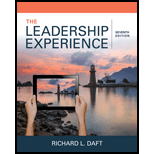
Bundle: The Leadership Experience, Loose-Leaf Version, 7th + MindTap Management, 1 term (6 months) Printed Access Card
7th Edition
ISBN: 9781337370004
Author: DAFT, Richard L.
Publisher: South-Western College Pub
expand_more
expand_more
format_list_bulleted
Question
Chapter 4, Problem 4DQ
Summary Introduction
To discuss: The way a leader has to deal with his rude and insensitive subordinate who is also not respectful towards others.
Expert Solution & Answer
Want to see the full answer?
Check out a sample textbook solution
Chapter 4 Solutions
Bundle: The Leadership Experience, Loose-Leaf Version, 7th + MindTap Management, 1 term (6 months) Printed Access Card
Knowledge Booster
Similar questions
- Identify and describe the three situational variables presented in Fiedlers contingency theory of leadership.arrow_forwardWhat are the defining characteristics of transformational and charismatic leaders?arrow_forwardWhat are substitutes for leadership? What are neutralizers? Give an example of each.arrow_forward
arrow_back_ios
arrow_forward_ios
Recommended textbooks for you
 Management, Loose-Leaf VersionManagementISBN:9781305969308Author:Richard L. DaftPublisher:South-Western College Pub
Management, Loose-Leaf VersionManagementISBN:9781305969308Author:Richard L. DaftPublisher:South-Western College Pub Understanding Management (MindTap Course List)ManagementISBN:9781305502215Author:Richard L. Daft, Dorothy MarcicPublisher:Cengage Learning
Understanding Management (MindTap Course List)ManagementISBN:9781305502215Author:Richard L. Daft, Dorothy MarcicPublisher:Cengage Learning

Management, Loose-Leaf Version
Management
ISBN:9781305969308
Author:Richard L. Daft
Publisher:South-Western College Pub


Understanding Management (MindTap Course List)
Management
ISBN:9781305502215
Author:Richard L. Daft, Dorothy Marcic
Publisher:Cengage Learning